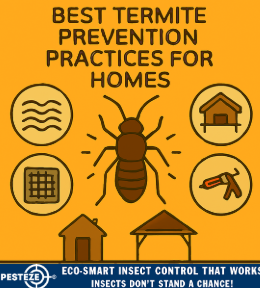BEST TERMITE PREVENTION PRACTICES FOR HOMES

BEST TERMITE PREVENTION PRACTICES FOR HOMES
SUMMARY
Termites are silent destroyers that can compromise the structure of your home if left unchecked. Prevention is the key to avoiding costly repairs and infestations. By combining moisture control, wood protection, natural repellents, and routine inspections, you can safeguard your home from termites and maintain a pest-free living space.
FEATURES
-
Control Moisture Levels – Reduce damp areas in and around the home.
-
Seal Cracks and Gaps – Block entry points where termites can invade.
-
Protect Wooden Structures – Apply sealants, oils, or treatments to exposed wood.
-
Use Natural Repellents – Orange oil, neem oil, and clove oil deter termites naturally.
-
Maintain Landscaping Wisely – Keep mulch, plants, and firewood away from the foundation.
-
Schedule Regular Inspections – Early detection prevents costly damage.
GUIDE DESCRIPTION
Termites cause billions of dollars in property damage every year, often going unnoticed until serious structural harm has already occurred. For homeowners, termite prevention is far more effective—and less expensive—than dealing with an active infestation. Fortunately, with the right practices, you can make your home far less appealing to termites.
One of the most important steps is controlling moisture levels. Termites thrive in damp environments, so fix leaky pipes, ensure proper ventilation in crawl spaces, and use dehumidifiers in basements. Keeping the home dry is the first line of defense.
Next, seal cracks and gaps around the foundation, windows, and doors. Even tiny openings provide entry points for termites. Caulking and weatherstripping not only block pests but also improve energy efficiency.
For added protection, treat and seal wooden structures. Use weather-resistant paint, stains, or natural oils such as linseed or tung oil. Outdoor decks, fences, and exposed beams are especially vulnerable and should be inspected and treated regularly.
Natural repellents provide a safe, eco-friendly solution. Oils like orange, neem, and clove are proven termite deterrents. These can be mixed with water to create a spray applied to wooden surfaces, reducing the chance of infestation.
Landscaping practices also play a big role. Avoid piling mulch, firewood, or plant debris against the home’s foundation, as these materials attract termites. Keep at least 18 inches between soil and wooden siding, and trim plants so they don’t touch exterior walls.
Finally, schedule regular inspections—either DIY or with professional pest control. Look for telltale signs like mud tubes, hollow-sounding wood, or termite droppings. Early detection prevents infestations from spreading and causing severe damage.
By managing moisture, sealing entry points, protecting wood, using natural repellents, maintaining smart landscaping, and inspecting regularly, you can prevent termites effectively. These best practices protect both your home’s value and your peace of mind.
- Shashank Rongali


Comments 0